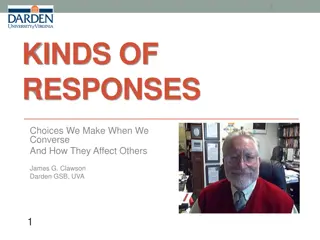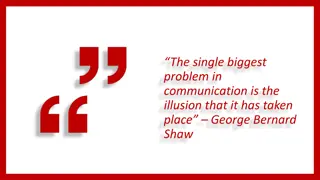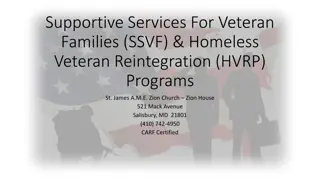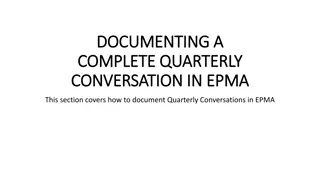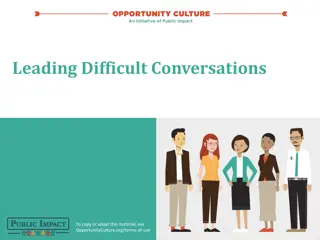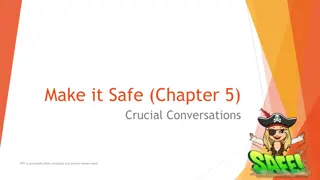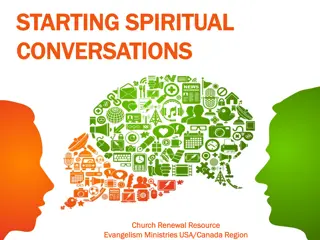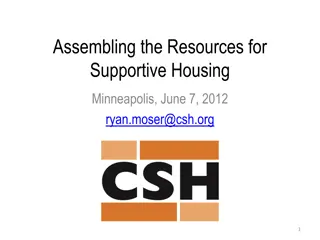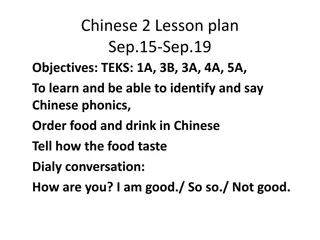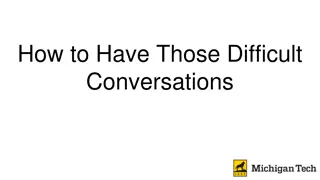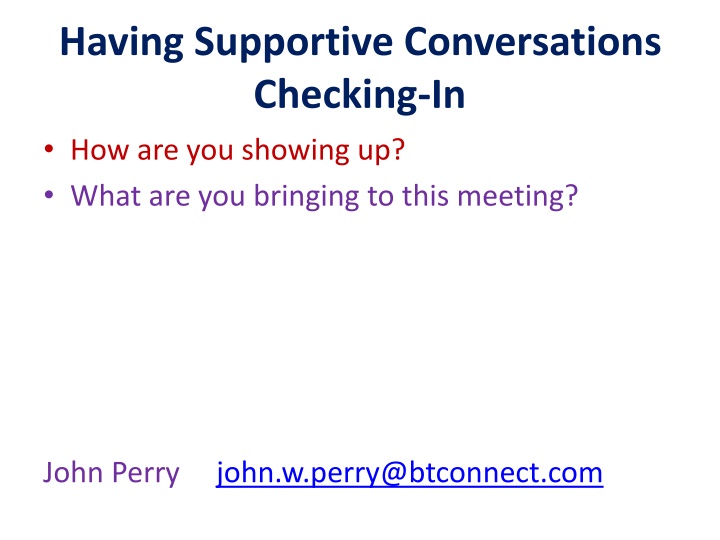
Supportive Conversations and Relationships: Professional Tips and Strategies
Enhance your communication skills with insights on supportive conversations, identifying problems, empathy, and perceptual positions. Understand the nuances of professional relationships and learn effective questioning techniques. Improve your overall approach to interactions and navigate various scenarios with confidence.
Uploaded on | 1 Views
Download Presentation

Please find below an Image/Link to download the presentation.
The content on the website is provided AS IS for your information and personal use only. It may not be sold, licensed, or shared on other websites without obtaining consent from the author. If you encounter any issues during the download, it is possible that the publisher has removed the file from their server.
You are allowed to download the files provided on this website for personal or commercial use, subject to the condition that they are used lawfully. All files are the property of their respective owners.
The content on the website is provided AS IS for your information and personal use only. It may not be sold, licensed, or shared on other websites without obtaining consent from the author.
E N D
Presentation Transcript
Having Supportive Conversations Checking-In How are you showing up? What are you bringing to this meeting? John Perry john.w.perry@btconnect.com
Whose Problem is it? MY YOUR PROBLEM OUR PROBLEM PROBLEM
I-It----------------------------------I-Thou Professional distance Closeness Boundaried Unboundaried Task-focused Relationship focused Separate (I am I, you are you) Connected (both part of a whole) Where on the continuum would you place your professional relationships? What are the strengths and limitations of each pole?
Questions to Ask.and Questions to Avoid.. Avoid: And how does that make you feel? (which implies that the person has no option but to feel the way they do) Do Ask: And how do you choose to respond? (which implies that the person chose their initial response and that other responses are available) Avoid: What s stopping you? (which implies that external events are the stumbling block) Do Ask: Who is stopping you? (which implies that the person themselves needs to get out of their own way)
Perceptual Positions 1st Position Your own reality. Your own views, values and knowledge of what you want and who you are. 2nd Position Understanding the world from someone else s perspective. Ability to put yourself in other s shoes. 3rd Position Objective, detached observer
Three positions Position 3 Seeing, hearing & feeling the situation through filters of an observer Position 2 Seeing, hearing & feeling the situation through filters of the other person Position 1 Seeing, hearing & feeling the situation through own filters
Perceptual Positions Most of us tend to favour one position Where do you spend most of your time?
After Action Review (AAR) This is a military de-briefing strategy, developed by the US army. It is also a v. good process for directing reflection. What did you set out to do? (eg. challenge colleague about poor timekeeping) What happened? (eg. angrily confronted colleague about arriving late) What went well? (eg. found the courage to confront colleague) What went badly? (eg. colleague stormed off) What have you learned? (eg. choose the right moment and setting to challenge lateness; gather information first and adopt a more supportive tone) What will you do differently? (eg. prepare better next time and be less confrontational) Reflecting on the past, in the present, for the future. This is a more structured version of the simpler Reflection: What? So What? Now What? Reflection is as much an emotional experience as a cognitive one (ie. how do you feel about this? is as important as what do you thinkabout this? )
Non-Violent Communication Marshall Rosenberg 1) I notice... (or I observe ) 2) That leaves me feeling (or That leaves me wondering ) 3) What I need is (or What would really help is ) 4) Therefore, my request is (or Therefore, I wonder if you would be prepared to )
Six Category Intervention Analysis John Heron. Authoritative Interventions: 1) Prescriptive: Giving Advice or Instructions. Being Critical or Directive. 2) Informative: Imparting New Knowledge, Instructing or Interpreting. 3) Confronting: Challenging a Restrictive Attitude or Behaviour, giving Direct Feedback, within a Caring Context.
Facilitative Interventions 4) Cathartic Seeking to Release Emotion in the form of Weeping, Laughter, Trembling or Anger. 5) Catalytic Encouraging the Discovery and Exploration of Latent Thoughts and Feelings. 6) Supportive Offering Comfort and Approval, affirming the Other s Intrinsic Value.
Having Supportive Conversations in Practice Which category of Intervention will you use in each of the following cases and why? (There is not necessarily a single correct answer) 1) A colleague says in a flat voice tone that they feel overwhelmed by their workload and unappreciated by senior colleagues. 2) A colleague expresses the view that patients who are unvaccinated only have themselves to blame if they contract Covid 19 and don t deserve to be treated. 3) A colleague says that they feel numb and empty inside Maybe it s compassion fatigue? They are concerned that their reserves of caring are depleted and that this is affecting how they relate to patients.
4) A colleague rolls their eyes, shakes their head and sighs heavily whilst you are talking. 5) A colleague discloses that they regularly smoke cannabis when off-duty, insisting that it s less harmful than alcohol and therefore not a problem. 6) A colleague appears to be lacking crucial knowledge in relation to their professional practice. 7) A colleague looks exhausted and appears to be struggling to stay awake. They appear also to be in need of a shower. 8) A colleague is talking excessively and constantly moving the agenda away from the issue you wish to discuss, dominating exchanges and not letting you claim your airspace . 9) A colleague makes a joke about female doctors being too emotional . 10) A colleague is excessively anxious because they have forgotten the entry code to a secure part of the practice.
Questions for Reflection. Authoritative Interventions: 1) Prescriptive: Giving Advice or Instructions. Being Critical or Directive. 2) Informative: Imparting New Knowledge, Instructing or Interpreting. 3) Confronting: Challenging a Restrictive Attitude or Behaviour, giving Direct Feedback, within a Caring Context. Facilitative Interventions: 4) Cathartic Seeking to Release Emotion in the form of Weeping, Laughter, Trembling or Anger. 5) Catalytic Encouraging the Discovery and Exploration of Latent Thoughts and Feelings. 6) Supportive Offering Comfort and Approval, affirming the Other s Intrinsic Value. Which of the above interventions do you find: Easiest Hardest Most Accepted Most Resisted Most Helpful And why? What are you assuming about yourself? What are you assuming about your colleagues?
How Assertive are You at Work? How Assertive are You at Work? Please think about and answer the following questions: 1. Can you give your colleagues feedback? 2. Can you accept a compliment about your work? 3. Can you tell your boss if you are dissatisfied at work? 4. Are you able to avoid being exploited by others? 5. Can you speak up at meetings? 6. Can you readily admit your mistakes? 7. Can you make decisions and accept the consequences? 8. When at fault can you apologise? 9. Can you ask for help from others? 10.Are you able to listen to criticism about yourself? 11.When confused, can you ask for clarification? 12.When a colleague makes an unreasonable request, can you refuse?
The Trust Equation (Green, C.H, & Howe, A.P, The Trusted Advisor Fieldbook, Wiley, 2012) TQ stands for Trust Quotient. Your Trust Quotient is a number (like IQ or EQ) that benchmarks your trustworthiness against 4 variables: 1) Credibility: This has to do with the words you speak. For example You can trust what she says about patient care. She s very credibleon the subject. 2) Reliability: This has to do with actions: For example: If he says he ll get back to you by tomorrow, you can relyon him to do it. 3) Intimacy: This refers to how safe people feel when entrusting you with something. For example: You can trust her with that information. She never betrays a confidence; and would never do anything to embarrass you. 4) Self-Orientation: This refers to your focus; in particular, whether your focus is primarily on yourself or on the other person. For example: You can t trust him on this. He doesn t care enough about you, he s just focused on what he can get out of the relationship.
Its all about People! The Trust Equation covers the most common meanings of trust that you encounter in the workplace. It s important to remember that the meanings are almost entirely personal, not institutional. People rarely give over their trust to institutions; really they trust (or don t trust) other people. For example, a person may not trust fully in the NHS; yet still have complete trust in their GP. Whilst companies may be described as trustworthy, it is really the people within those companies that make them what they are. Trust in all professional (and social) encounters requires good scores on all 4 of the variables in the Trust Equation: You should strive for high Credibility, Reliability and Intimacy and low Self-Orientation. Living according to these 4 Trust Values is the best way to increase your trustworthiness. Quantifying Trust: Credibility (1-10) + Reliability (1-10) + Intimacy (1-10) divided by Self-Orientation (1-10) = Trust Quotient. Perfection would be a score of 30. A more realistic goal may be 10-15. What do you feel is your TQ?
Primal Wounds There are 4 primal wounds: Abandonment, Engulfment, Hurt & Non- Relationship. 1) Abandonment eg. If you don t shut up, we ll put you out of the car and drive off! 2) Engulfment ie. where the child is taken over , eg. overly-swaddled, told what to do, what to eat, what to think, etc. 3) Hurt ie. physically hurt (eg. smacked) or physically abused. 4) Non-relationship ie. growing up in a family where there is no intimacy, no close relationships, no real contact, etc. Exercise Abandonment: One person talks to another. After a while, the listener looks elsewhere in the room to create a sense of abandonment. If you have a primal wound of abandonment, this will produce a rubber- band experience. Engulfment: One person talks about something important to them, the other moves too close, takes over the conversation and tells the other person what to think.
People who experienced engulfment in their childhood will want more physical distance than typical colleagues. If you have a primal wound of engulfment, this will provoke a rubber-band experience. Hurt: Watch for clients hyper-vigilance for physical threats (eg. child who flinches when teacher reaches for a book from a high shelf). Non-Relationship: One person talks about something important to them; the other person has eye contact with them, but is thinking of something else while the partner is talking. (eg. when talking to someone at a party; they re having eye contact with you, but you sense they re not really listening). If your primal wound is non-relationship, this will provoke the transference. A Self-Fulfilling Prophecy. If abandonment is your primal wound, you are likely to attempt to engulf people, who are likely to respond by abandoning you, which reinforces your belief that you will always be abandoned.

